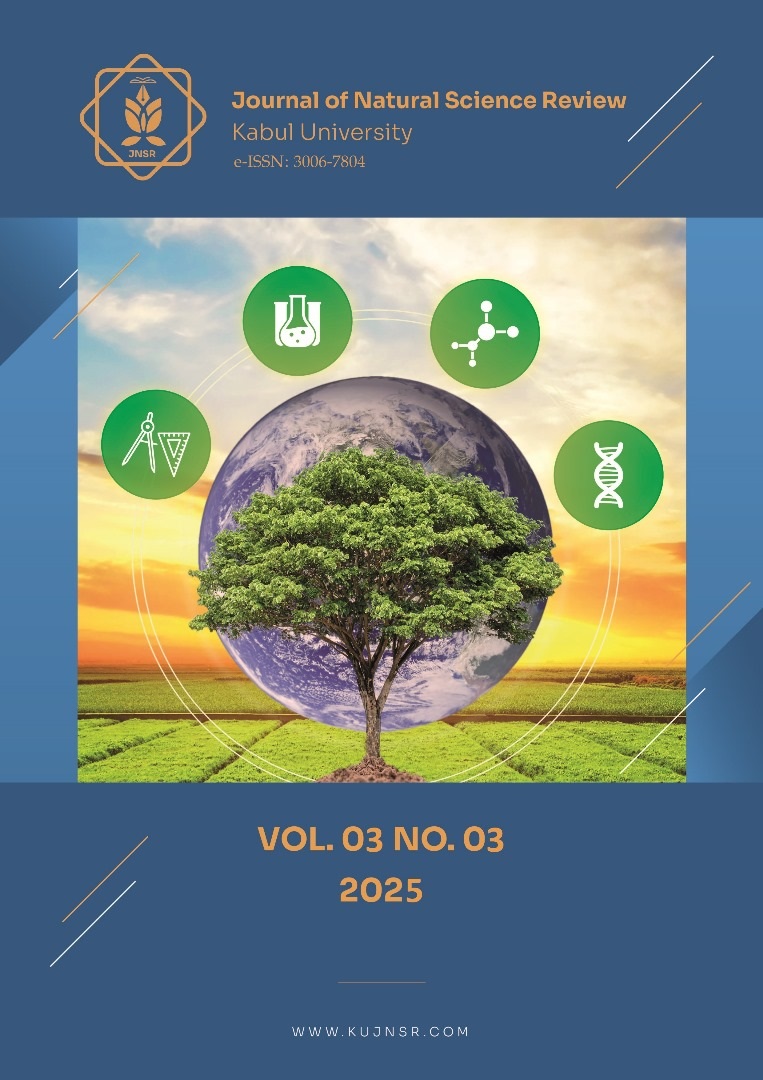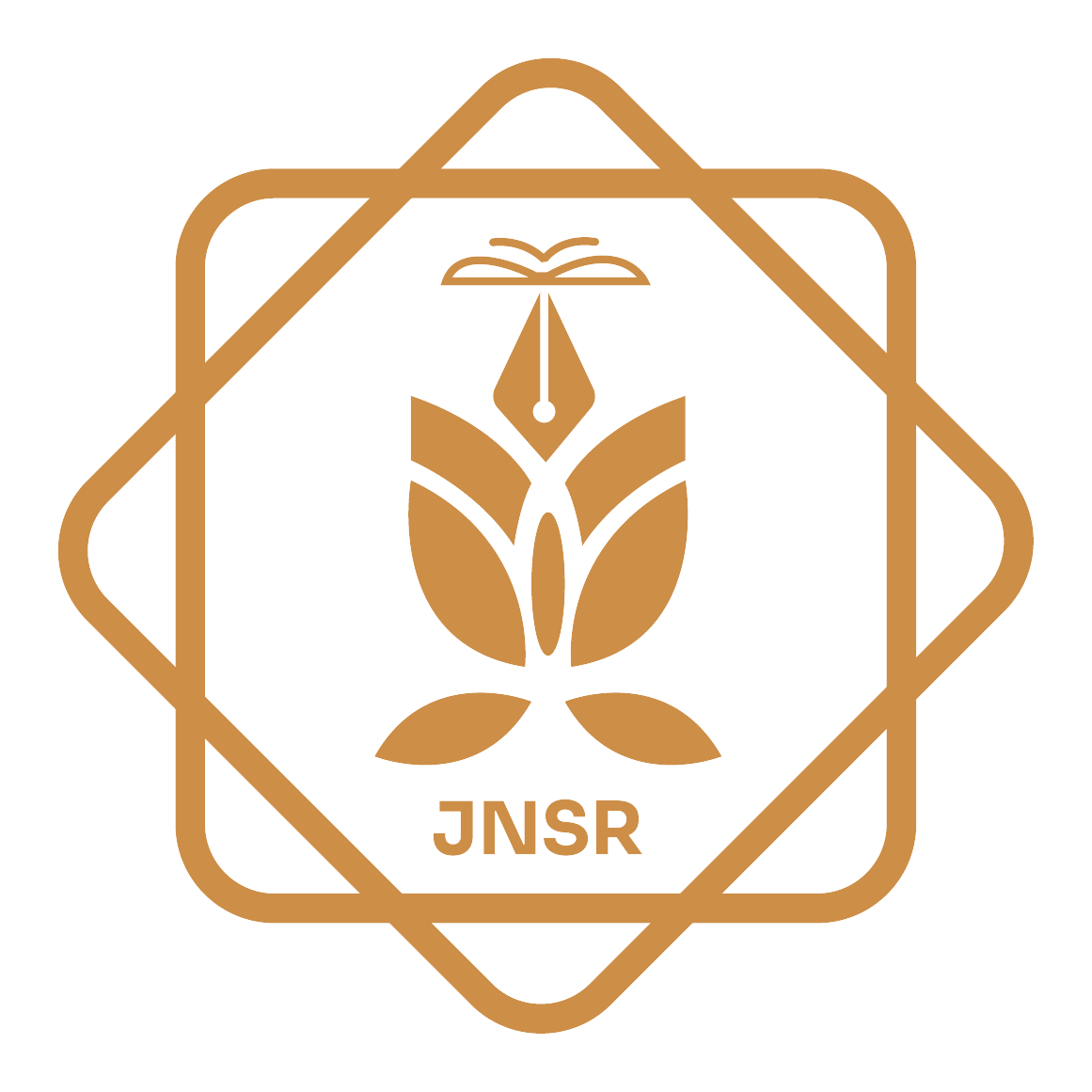Impacts of Humic Acid on Growth, Yield, and Quality of Tomato: A Review
DOI:
https://doi.org/10.62810/jnsr.v3i3.215Keywords:
Growth, Humic acid, Quality, Tomato, YieldAbstract
Tomato (Solanum lycopersicum) is one of the most adaptable, popular, and widely consumed vegetable crops in the world. However, current production levels of tomatoes fall short of consumer needs. Enhancing soil fertility presents a viable solution to address the issue of low productivity in tomato cultivation. Humic acids (HA) are organic molecules that significantly improve soil characteristics, plant growth, yield, and quality. There was limited information available in previous studies regarding the issue; therefore, the review was conducted to investigate the issue in greater detail. The review aims to consolidate existing knowledge on the topic and encourage further investigation to refine agricultural practices and enhance crop production. In the narrative literature, keywords related to the topic investigated in popular databases over the last three decades were screened for relevant papers, and the information was presented in different sections of the manuscript. The application of humic acid has positively influenced several parameters, including growth, development, yield, and quality of tomatoes. Humic acid increased the stem diameter, number of leaves per plant, and plant height. Additionally, humic acid topically improved fruit weight, fruit diameter, fruit number per plant, and yield. Furthermore, skin color, lycopene content, fruit juice acidity, ascorbic acid, and total soluble solids were all markedly improved by applying humic acid. The information synthesized here may benefit policymakers, agricultural advisors, and experts in the field, supporting the development of effective strategies for sustainable tomato production using humic acid.
Downloads
References
Abdelkader, M. M., Puchkov, M. Y., Lysakov, M. A., Loktionova, E. G., & Suliman, A. A. (2019). Effect Of Crezacin And Humic Acid On Growth And Physiological Aspects Of Tomato Plants (Lycopersicon esculentum). Journal of Applied Horticulture, 21(1), 1. https://doi.org/10.37855/jah.2019.v21i01.11. DOI: https://doi.org/10.37855/jah.2019.v21i01.11
Abdellatif, I., Abdel-Ati, Y. Y., Abdel-Mageed, Y. T., & Hassan, M. A. M. M. (2017). Effect of humic acid on growth and productivity of tomato plants under heat stress. Journal of Horticultural Research, 25(2), 45–54. https:// doi.org/45–54. 10.1515/johr-2017-0022. DOI: https://doi.org/10.1515/johr-2017-0022
Abdel-Mawgoud, A. M. R., El-Greadly, N. H. M., Helmy, Y. I., & Singer, S. M. (2007). Responses of tomato plants to different rates of humic-based fertilizer and NPK fertilization. Journal of Applied Sciences Research, 3(2), 169–174. Link
Adani F., Sepagnol, M. & Nierop, K.G.J. (2006). Biochemical Origin And Refractory Properties Of Humic Acid Extracted From Maize Plants. Biogeochemistry, 82(1), 55-65.. https:// doi.org/ 10.1007/s10533-005-2902-7. DOI: https://doi.org/10.1007/s10533-006-9052-4
Alenazi, M.M. & Khandaker, M.M. (2021). Responses Of Tomato Hybrid Cultivars To Soil Application Of Humic Acid Under Greenhouse Conditions. Brazilian Journal of Biology, 84, 1-11. https:// doi.org/10.1590/1519-6984.252573. DOI: https://doi.org/10.1590/1519-6984.252573
Ampong, K., Thilakaranthna, M. S., & Gorim, L. Y. (2022). Understanding The Role Of Humic Acids On Crop Performance And Soil Health. Front. Agron., 4, 848621, 1-12. https:// doi.org/10.3389/fagro.2022.848621. DOI: https://doi.org/10.3389/fagro.2022.848621
Asri, F.O, Demirtas, E.I. & Ari, N. (2015). Changes In Fruit Yield, Quality And Nutrient Concentrations In Response To Soil Humic Acid Applications In Processing Tomato. Bulg. J. Agric. Sci., 21, 585-591. Link
Asri, F.O. (2021). The Importance of Humic Substances in Tomato Production. Freseniuce Environmetal bulletin, 30, 4155-4162 Link
Canellas, L. P., Canellas, N. O., da S. Irineu, L. E. S., Olivares, F. L., & Piccolo, A. (2020). Plant Chemical Priming By Humic Acids. Chemical and Biological Technologies in Agriculture, 7, 1-17. https:// doi.org/10.1186/s40538-020-00178-4. DOI: https://doi.org/10.1186/s40538-020-00178-4
Canellas, L. P., Piccolo, A., Dobbss, L. B., Spaccini, R., Olivares, F. L., Zandonadi, D. B.,. (2010). Chemical Composition And Bioactivity Properties Of Size-Fractions Separated From A Vermicompost Humic Acid. Chemosphere, 78, 457-466. https:// doi.org/10.1016/j.chemosphere.2009.10.018. DOI: https://doi.org/10.1016/j.chemosphere.2009.10.018
Cimrin, K. M., Turkmen, O., Turan, M., & Tuncer, B. (2010). Phosphorus and humic acid application alleviate salinity stress of pepper seedling. African Journal of Biotechnology, 9(36), 5845–5851. Link
Davies, G., Ghabbour, E. A., & Steelink, C. (2001). Humic acids: Marvelous products of soil chemistry. Journal of Chemical Education, 78(12), 1609. https://doi.org/pubs.acs.org/doi/abs/10.1021/ed078p1609. DOI: https://doi.org/10.1021/ed078p1609
De Melo, B. A. G., Motta, F. L., & Santana, M. H. A. (2016). Humic Acids: Structural Properties And Multiple Functionalities For Novel Technological Developments. Mater. Sci. Eng. C., 62, 967-974. https:// doi.org/10.1016/j.msec.2015.12.001. DOI: https://doi.org/10.1016/j.msec.2015.12.001
Demirtaş, E., Öktüren Asri, F., & Arı, N. (2014). The Effects Of Humic Acid On Nutrient Status Yield And Quality Of Tomato. Derim, 31(1), 1-16. Link DOI: https://doi.org/10.16882/derim.2014.86373
Dunoyer, A. A. T., Castillo, F. C., & Camargo, J. M. (2022). Effect Of Humic Acid On The Growth Of Seedling Tomato (Solanum lycopersicum) And Melon (Cucumis melo). Revista Ambiente & Água, 17(4), 1-11. https:// doi.org/10.4136/ambi-agua.2808. DOI: https://doi.org/10.4136/ambi-agua.2808
Dursun, A., Güvenç, I., & Turan, M. (2002). Effects of different levels of humic acid on seedling growth and macro and micronutrient contents of tomato and eggplant. Acta Agrobotanica, 55(2), 81-88. Link DOI: https://doi.org/10.5586/aa.2002.046
Elankavi, S., Nambi, J., Ramesh, S., Jawahar, S., & Lavanya, K. (2020). Influence Of Different Doses Of Fertilizers And Foliar Spray Of Nutrients On Yield And Yield Attributes Of Rice. Annals of the Romanian Society for Cell Biology, 1127-1134. Link
FAOSTAT. (2023). Production: Crops and livestock products. Accessed on 26th June 2023. Link
Friedman, M. (2013). Anticarcinogenic, Cardioprotective, And Other Health Benefits Of Tomato Compounds Lycopene, Α-Tomatine, And Tomatidine In Pure Form And In Fresh And Processed Tomatoes. Journal of Agricultural and Food Chemistry, 61(40), 9534-9550. https://doi.org/ 10.1021/jf402654e. DOI: https://doi.org/10.1021/jf402654e
Garciá, A. C., De Souza, L. G. A., Pereira, M. G., Castro, R. N., Garciá-Mina, J. M., Zonta, E., et al. (2016). Structure-Property-Function Relationship In Humic Substances To Explain The Biological Activity In Plants. Sci. Rep., 6, 20798. https:// doi.org/10.1038/srep20798. DOI: https://doi.org/10.1038/srep20798
García, A. C., van Tol de Castro, T. A., Santos, L. A., Tavares, O. C. H., Castro, R. N., Berbara, R. L. L., et al. (2019). Structure-Property-Function Relationship Of Humic Substances In Modulating The Root Growth Of Plants: A Review. J. Environ. Qual., 48, 1622-1632. https:// doi.org/10.2134/jeq2019.01.0027. DOI: https://doi.org/10.2134/jeq2019.01.0027
Haghighi, M., & Teixeira Da Silva, J. A. (2013). Amendment Of Hydroponic Nutrient Solution With Humic Acid And Glutamic Acid In Tomato (Lycopersicon esculentum Mill.) Culture. Soil Science and Plant Nutrition, 59(4), 642-648. https:// doi.org/10.1080/00380768.2013.809599. DOI: https://doi.org/10.1080/00380768.2013.809599
Helaly, A. A. (2021). Enhancing the Productivity and Quality of Tomato using Magnetized Water and Humic Acid as Bio-stimulant Agents. Indian Journal of Agricultural Research, 55(6), 645. https:// doi.org/10.18805/IJARe.A-616. DOI: https://doi.org/10.18805/IJARe.A-616
Ilodibia, C. V., & Chukwuma, M. U. (2015). Effects Of Application Of Different Rates Of Poultry Manure On The Growth And Yield Of Tomato (Lycopersicum esculentum Mill.). Journal of Agronomy, 14(4), 251-253. https:// doi.org/10.3923/ja.2015.251.253. DOI: https://doi.org/10.3923/ja.2015.251.253
Jindo, K., Canellas, L. P., Albacete, A., Figueiredo dos Santos, L., Frinhani Rocha, R. L., Carvalho Baia, D., ... & Olivares, F. L. (2020). Interaction Between Humic Substances And Plant Hormones For Phosphorous Acquisition. Agronomy, 10(5), 640. https:// doi.org/10.3390/agronomy10050640. DOI: https://doi.org/10.3390/agronomy10050640
Kazemi, M. (2014). Effect of foliar application of humic acid and calcium chloride on tomato growth. Bulletin of Environment, Pharmacology and Life Sciences, 3(3), 41-46. Link
Khaled, H., & Fawy, H. A. (2011). Effect Of Different Levels Of Humic Acids On The Nutrient Content, Plant Growth, And Soil Properties Under Conditions Of Salinity. Soil and Water Research, 6(1), 21-29. https:// doi.org/21. 10.17221/4/2010-. DOI: https://doi.org/10.17221/4/2010-SWR
Kumar, R., Srivastava, K., Singh, N. P., Vasistha, N. K., Singh, R. K., & Singh, M. K. (2013). Combining Ability Analysis For Yield And Quality Traits In Tomato (Solanum lycopersicum L.). Journal of Agricultural Science, 5(2), 213. https:// doi.org/10.5539/jas.v5n2p213. DOI: https://doi.org/10.5539/jas.v5n2p213
Mallick, P. K. (2021). Medicinal values of tomato (Lycopersicon esculentum Mill.–Solanaceae). International Journal of Applied Sciences and Biotechnology, 9(3), 166-168. https://10.3126/ijasbt.v9i3.39789. DOI: https://doi.org/10.3126/ijasbt.v9i3.39789
Mirza, M. A., Agarwal, S. P., Rahman, M. A., Rauf, A., Ahmad, N., Alam, A., ….. (2011). Role Of Humic Acid On Oral Drug Delivery Of An Antiepileptic Drug. Drug Dev. Ind. Pharm., 37, 310-319. https:// doi.org/10.3109/03639045.2010.512011. DOI: https://doi.org/10.3109/03639045.2010.512011
Nardi, S., Schiavon, M., & Francioso, O. (2021). Chemical Structure And Biological Activity Of Humic Substances Define Their Role As Plant Growth Promoters. Molecules, 26(8), 2256. https://doi.org/10.3390/ molecules26082256. DOI: https://doi.org/10.3390/molecules26082256
Ola, O. S. (2024). Effect of Poultry Manure and NPK (15: 15: 15) Fertilizer on The Growth and Yield of Tomato (Lycopersicon esculentum L.). American Journal of BioScience, 9(3), 133-138. https:// doi.org/10.11648/j.ajbio.20241204.15. DOI: https://doi.org/10.11648/j.ajbio.20241204.15
Olaetxea, M., Mora, V., Baigorri, R., Zamarreño, A. M., & García-Mina, J. M. (2020). The Singular Molecular Conformation Of Humic Acids In Solution Influences Their Ability To Enhance Root Hydraulic Conductivity And Plant Growth. Molecules, 26(1), 1-12. https:// doi.org/10.3390/molecules26010003. DOI: https://doi.org/10.3390/molecules26010003
Osman, A. S., & Rady, M. M. (2014). Effect Of Humic Acid As An Additive To Growing Media To Enhance The Production Of Eggplant And Tomato Transplants. The Journal of Horticultural Science and Biotechnology, 89(3), 237-244. https:// doi.org/10.1080/14620316.2014.11513074. DOI: https://doi.org/10.1080/14620316.2014.11513074
Padem, H. & Ocal, A. (1999). Effects Of Humic Acid Applications On Yield And Some Characteristics Of Processing Tomato. Acta Hortic., 487, 159-164. https:// doi.org/10.17660/ActaHortic.1999.487.20. DOI: https://doi.org/10.17660/ActaHortic.1999.487.20
Rajendiran, S. & Purakayastha, T.J. (2014). Effect Of Humic Acid Multinutrient Complex Fertilizers On Yield And Quality Of Tomato And Potato. Vegetable Science, 41(2), 155-159. Link
Rose, M. T., Patti, A. F., Little, K. R., Brown, A. L., Jackson, W. R., & Cavagnaro, T. R. (2014). A Meta-Analysis And Review Of Plant-Growth Response To Humic Substances: Practical Implications For Agriculture. Advances in agronomy, 124, 37-89. https:// doi.org/10.1016/B978-0-12-800138-7.00002-4. DOI: https://doi.org/10.1016/B978-0-12-800138-7.00002-4
Rupiasih, N. N. (2005). A Review: Compositions, Structures, Properties And Applications Of Humic Substances. J. Adv. Sci. Technol., 8, 16-25. Link
Salihi, M. S., Hamim, H., & Serat, S. M. (2024). Impacts of Humic Acid on Growth and Yield of Wheat A Review. Journal of Natural Science Review, 2(3), 87–96. https://doi.org/1062810/jnsr.v2i3.81. DOI: https://doi.org/10.62810/jnsr.v2i3.81
Shah, Z. H., Rehman, H. M., Akhtar, T., Alsamadany, H., Hamooh, B. T., Mujtaba, T., ... & Chung, G. (2018). Humic Substances: Determining Potential Molecular Regulatory Processes In Plants. Frontiers in plant science, 9, 263. https:// doi.org/10.3389/fpls.2018.00263. DOI: https://doi.org/10.3389/fpls.2018.00263
Stevenson, F.J. (1994). Humus Chemistry: Genesis, Composition, Reactions. John Wiley & Sons.Link
Suliman, A.A., Abramov A.G., Shalamova A.A., Badran A.M. (2020). Effect Of Humic Acid And Naphthalene Acetic Acid On Vegetative Growth And Fruit Quality Of Tomato Plants Lycopersicon esculentum. Journal of Agronomy and Animal Industries, 15(1), 30-39. https:// doi.org/10.22363/2312-797X-2020-15-1-30-39. DOI: https://doi.org/10.22363/2312-797X-2020-15-1-30-39
Ural, C., Halime Özdamar Ünlü, Erkan, İ. E., & Ufuk Çelikkol Akçay. (2023). Influence of Humic Acid on Some Physiological Characteristics and Antioxidant Enzyme Genes Expression in Tomato (Solanum lycopersicum) Grown under Salt Stress Conditions. Alatarim, 22(2), 86-97.Link
Usman, M. (2015). Cow Dung, Goat And Poultry Manure And Their Effects On The Average Yields And Growth Parameters Of Tomato Crop. Journal of Biology, Agriculture and Healthcare, 5(5), 7-11. Link
van Tol de Castro, T. A., Berbara, R. L. L., Tavares, O. C. H., Mello, D. F., & da, G., Pereira, E. G. (2021). Humic Acids Induce A Eustress State Via Photosynthesis And Nitrogen Metabolism Leading To A Root Growth Improvement In Rice Plants. Plant Physiol. Biochem., 162, 171-184. https:// doi.org/10.1016/j.plaphy.2021.02.043. DOI: https://doi.org/10.1016/j.plaphy.2021.02.043
Wu, S., Li, R., Peng, S., Liu, Q., & Zhu, X. (2017). Effect Of Humic Acid On Transformation Of Soil Heavy Metals. IOP Conference Series: Materials Science and Engineering, 207, 012089. https:// doi.org/10.1088/1757-899X/207/1/012089. DOI: https://doi.org/10.1088/1757-899X/207/1/012089
Yang, F., & Antonietti, M. (2020). The Sleeping Giant: A Polymer View On Humic Matter In Synthesis And Applications. Prog. Polym. Sci., 100, 101182. https:// doi.org/10.1016/j.progpolymsci.2019.101182. DOI: https://doi.org/10.1016/j.progpolymsci.2019.101182
Yang, F., Tang, C., & Antonietti, M. (2021). Natural And Artificial Humic Substances To Manage Minerals, Ions, Water, And Soil Microorganisms. Chemical Society Reviews, 50(10), 6221-6239. https:// doi.org/10.1039/D0CS01363C. DOI: https://doi.org/10.1039/D0CS01363C
Yildirim, E. (2007). Foliar And Soil Fertilization Of Humic Acid Affect Productivity And Quality Of Tomato. Acta Agriculturae Scandinavica Section B-Soil and Plant Science, 57(2), 182-186. https:// doi.org/10.1080/09064710600813107. DOI: https://doi.org/10.1080/09064710600813107
Downloads
Published
How to Cite
Issue
Section
License
Copyright (c) 2025 Rahimullah Himatkhwah, Mohammad Sadiq Salihi, Muhibullah Faizi, Mirwais Khan Afghan

This work is licensed under a Creative Commons Attribution-NonCommercial 4.0 International License.



























